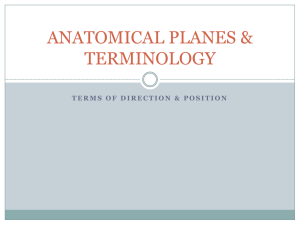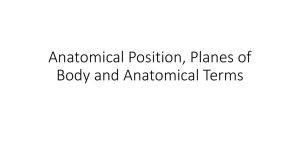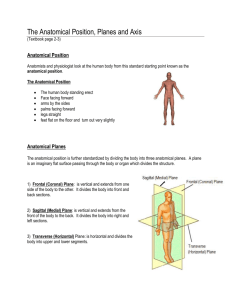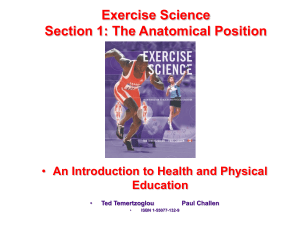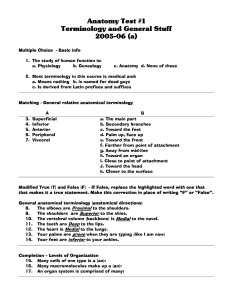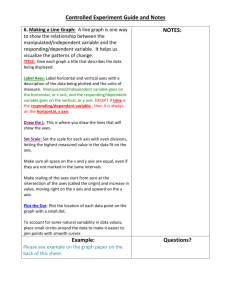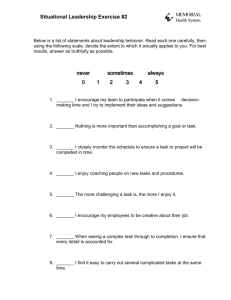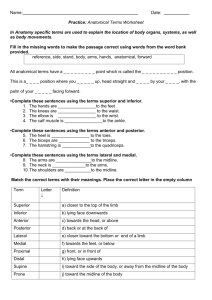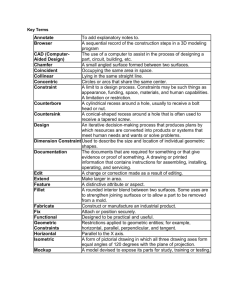The Anatomical Position:
advertisement
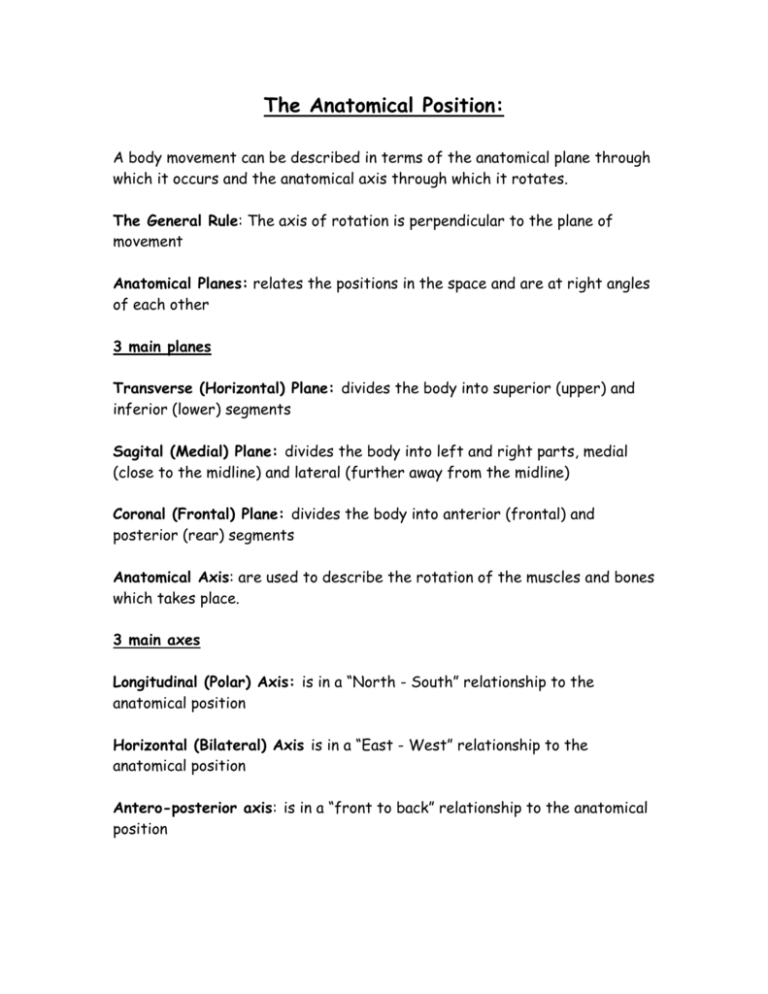
The Anatomical Position: A body movement can be described in terms of the anatomical plane through which it occurs and the anatomical axis through which it rotates. The General Rule: The axis of rotation is perpendicular to the plane of movement Anatomical Planes: relates the positions in the space and are at right angles of each other 3 main planes Transverse (Horizontal) Plane: divides the body into superior (upper) and inferior (lower) segments Sagital (Medial) Plane: divides the body into left and right parts, medial (close to the midline) and lateral (further away from the midline) Coronal (Frontal) Plane: divides the body into anterior (frontal) and posterior (rear) segments Anatomical Axis: are used to describe the rotation of the muscles and bones which takes place. 3 main axes Longitudinal (Polar) Axis: is in a “North - South” relationship to the anatomical position Horizontal (Bilateral) Axis is in a “East - West” relationship to the anatomical position Antero-posterior axis: is in a “front to back” relationship to the anatomical position Relationship between the Planes & Axes: Axis of Rotation Horizontal (Bilateral) Longitudinal (Polar) AntereoPosterior Plane of Motion Sagital (Medial) Transverse (Horizontal) Coronal (Frontal) Example Trunk Flexion, & Extension Rotation of Extremities Abduction, Adduction Describing Position & Movement: - anterior – front surface of the body - posterior – rear surface of the body - superior – refers to the structure being closer to the top of the body (Note: Doesn’t include arms and legs) - inferior – refers to the structure being closer to the bottom of the body (Note: Doesn’t include arms and legs) - medial - towards the midline/ mid-sagittal - lateral – away from the midline/ mid-sagittal - proximal – towards the upper segment of the limb - distal - away from the upper segment of the limb Basic Movements Involving a Joint - flexion – decreasing the angle between a joint - extension – increasing the angle between a joint - adduction – moving towards the midline - abduction – moving away from the midline - internal (medial) rotation – rotating medially toward the midline - external (lateral) rotation-rotating laterally away from the midline - circumduction – a circular motion that is a combination of flexion, extension, adduction & adduction (only occurs at shoulders & hips) - supination – lateral rotation of the forearm/ hand - pronation - medial rotation of the forearm/ hand - plantar flexion – pointing the foot downwards/ inferiorly - dorsiflexion - pointing the foot upwards/ superiorly - elevation – movement of the shoulders superiorly - depression - movement of the shoulders inferiorly - opposition – special motion that allows the thumb to touch the fingers - inversion – movement of the foot towards the medial plane with the foot facing inwards (common method of rolling ankle) - eversion - movement of the foot towards the lateral plane with the foot facing outwards Movement Axis of Rotation Plane of Motion Stride Jump Cart Wheel Elbow Extension Nodding Yes Tuck Somersault Twirling Shaking Head No Anterior-posterior Anterior-posterior Horizontal Horizontal Horizontal Horizontal Polar Polar Frontal Frontal Medial Medial Medial Medial Horizontal Horizontal Helpful Hints: The axis of rotation is always perpendicular to the plane of movement. Therefore, from anatomical position: Flexion & Extension – always occur through medial plane & rotate around the horizontal axis Adduction & Adduction – always occur through frontal plane & rotate around the anterior-posterior axis Medial & Lateral Rotation – always occur through horizontal plane & rotate around the polar axis The Anatomical Position: A body movement can be described in terms of the anatomical plane through which it occurs and the anatomical axis through which it rotates. The General Rule: The axis of rotation is perpendicular to the plane of movement Anatomical Planes: relates the positions in the space and are at right angles of each other Transverse (Horizontal) Plane: Sagital (Medial) Plane: Coronal (Frontal) Plane: Anatomical Axis: are used to describe the rotation of the muscles and bones which takes place. Longitudinal (Polar) Axis: Horizontal (Bilateral) Axis Antero-posterior axis: Relationship between the Planes & Axes: Axis of Rotation Horizontal (Bilateral) Plane of Motion Sagital (Medial) Longitudinal (Polar) Transverse (Horizontal) Example Trunk Flexion, & Extension Rotation of Extremities Antereo-Posterior Coronal (Frontal) Abduction, Adduction Describing Position & Movement: - anterior - posterior - superior - inferior - medial - lateral - proximal - distal Basic Movements Involving a Joint - flexion - extension - adduction - abduction - adduction - internal rotation - external rotation - circumduction - supination - pronation - inversion - eversion - plantar flexion - dorsiflexion - elevation - depression - opposition Movement Stride Jump Cart Wheel Elbow Extension Nodding Yes Tuck Somersault Twirling Shaking Head No Helpful Hints: Axis of Rotation Plane of Motion
